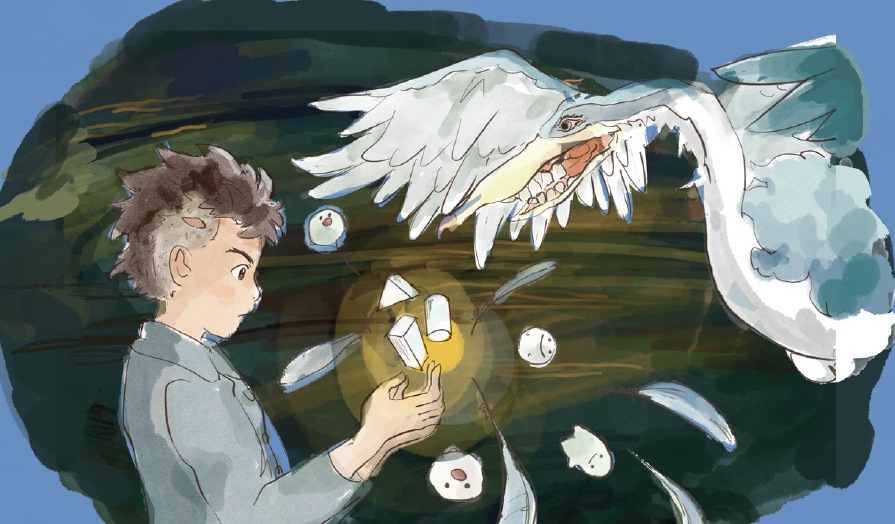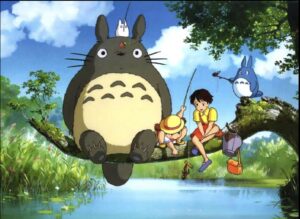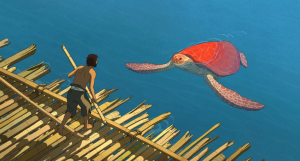Hayao Miyazaki is infamously bad at staying retired. In 2013, the legendary Studio Ghibli director claimed that The Wind Rises would be his final work. Then, in 2018, he came out of retirement to produce Boro the Caterpillar, a short film touted as his last hurrah. And yet, he’s outdone himself one last time with The Boy and the Heron (2023), a heart-wrenching, whimsical, and brilliant tale of grief and resilience.
As the film begins, we’re introduced to a young Mahito (Soma Santoki), our malevolent protagonist, as he runs toward a burning hospital where his mother is working. Flames engulf the entire screen as fear and angst overtake his body, visually representing the disorientation and claustrophobia one can experience during a panic attack. His mother’s death forces Mahito and his father, who runs a fighter plane factory, to move to the countryside where Mahito’s new stepmother (Yoshino Kimura) resides. Mahito struggles with adjusting to his new life and, in an attempt to avoid returning to school, strikes his head with a stone. Upon seeing the wound, Mahito’s father just vows to punish the bullies he assumes are responsible; his agonizing failure to recognize his son’s true emotional turmoil makes the cuts burn deeper.
Miyazaki’s own childhood was fraught with uncanny parallels to Mahito’s story: the filmmaker grew up during World War II and fled Tokyo for rural Japan with his family, where his father also worked at a fighter plane factory. The film’s semi-autobiographical nature suggests the film might serve as Miyazaki’s personal reflection on life and living.
As Mahito remains haunted by the painful memory of his mother, a terrifying gray heron lures him into a mysterious tower near his home. In a quintessentially Ghibli turn of events, the tower reveals itself to be a portal to a fantastical, surreal underworld where the dead and the unborn—and a kingdom of parakeets, among other side characters—reside.
Despite being so closely intertwined with the melancholia of death, this magical world is beautiful and breathtaking. Miyazaki has always crafted dreamscapes that push the boundaries of human imagination, but even by the high standards of Studio Ghibli animation, this is undeniably his most artistic, detailed, and masterful creation. Stunning illustrations of night skies and saturated sunsets are accompanied by mystical forests and interrupted by blazing rings of fire. Compared to previous Ghibli films, the art style leans the heaviest into horror undertones, evoking a sense of unease beneath its aesthetic charm. Yet another outstanding Joe Hisaishi musical score elevates the depth of each visual, curating a truly exhilarating viewing experience.
Miyazaki’s underworld is home to a menagerie of otherworldly creatures that confound mortal notions of time and existence. The most life-changing addition to Mahito’s quest is Lady Himi (Karen Fukuhara), a girl with the power to cast fire who is implied to be a younger incarnation of his mother. With Himi’s guidance, Mahito discovers that this world was created by his granduncle, but as his granduncle is aging, the world itself is also rapidly unraveling. As the earth crumbles and the sky falls, the characters must return to their original worlds to stay alive—and because Mahito and Himi exist at different points in time, they must return to their respective realms, forever a universe away.
The Boy and the Heron doesn’t have a typical hero nor a typical happy ending. Knowing that Himi will inevitably die in the hospital fire, Mahito begs her to stay, but she smiles and tells him that because she gets to give birth to him, everything is okay. The plot dances impossibly between space and time, making your head throb if you try to pin your finger on the exact logic of it all. Still, its emotional message rings loud and clear. It’s a story of acceptance—acceptance that malice and death are inherent parts of human existence. As Himi’s last words signify, a full life lived isn’t one that manages to erase the inevitable, but cherishes every day more because of it.
In some ways, the film’s cryptic and ominous imagery makes the audience’s job more difficult than it ought to be. For newer viewers unfamiliar with Miyazaki’s tendency to jump between dimensions and Studio Ghibli’s host of peculiar and bizarre character species, trying to piece together how each plot arc fits into one overarching story is a baffling and daunting task. Its ambiguous ending certainly doesn’t help either: we don’t know whether Mahito follows in his granduncle’s footsteps, remedies his relationship with his father, or ever stops mourning the death of his mother.
It’s arguably a disjointed movie, but it’s definitely not thoughtless or lazy scriptwriting. Instead, the beauty is in the chaos. As Mahito steps through the door to his home, he turns around to see the tower crumbling, and yet the destruction of his granduncle’s world is not apocalyptic—it simply means it’s time for Mahito to create his own. While most viewers have interpreted the epilogue as an allegory for how Miyazaki has made peace with the nature of being mortal, some believe it also symbolizes how the director views his legacy at Studio Ghibli. In both instances, his outlook is that uncertainty is not synonymous with calamity.
Despite the “cozy Ghibli aesthetic” that pop culture adores, the studio’s films have always been more than pretty pastel colors and soothing instrumentals. Each Ghibli film is a parable of adulthood and being, and The Boy and the Heron is arguably Miyazaki’s darkest tale of all. Perhaps it was deliberately crafted from the perspective of a director who knows he has already told a myriad of stories with universally beloved characters and satisfying resolutions. For his last work, Miyazaki chose to create something polarizing and confusing—something that will make every audience member ruminate, reflect, and likely rewatch.
The Boy and the Heron’s Japanese title is shared with the 1937 Japanese book How Do You Live? That correspondence isn’t a mere coincidence—the novel’s title is the exact question the movie poses. Without a straightforward plot resolution or a concrete answer to its deeper existential themes, the film challenges us to confront our own internal conflicts at every twist and turn of its beauty and horror. As much as we want to know how Mahito will live, Miyazaki also asks us: how do you live?





